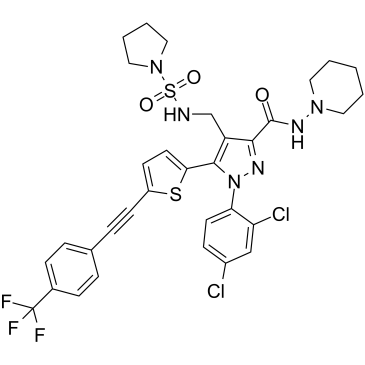| Cas No.: | 1429239-98-4 |
| Synonyms: | DBPR 211,DBPR-211;DBPR211 |
| SMILES: | C1CCN(CC1)NC(=O)C2=NN(C(=C2CNS(=O)(=O)N3CCCC3)C4=CC=C(S4)C#CC5=CC=C(C=C5)C(F)(F)F)C6=C(C=C(C=C6)Cl)Cl |
| Formula: | C33H31Cl2F3N6O3S2 |
| M.Wt: | 750.12 |
| Purity: | >98% |
| Sotrage: | 2 years -20°C Powder, 2 weeks 4°C in DMSO, 6 months -80°C in DMSO |
| Publication: | [1]. Chang CP, et al. Discovery of 1-(2,4-dichlorophenyl)-N-(piperidin-1-yl)-4-((pyrrolidine-1-sulfonamido)methyl)-5-(5-((4-(trifluoromethyl)phenyl)ethynyl)thiophene-2-yl)-1H-pyrazole-3-carboxamide as a novel peripherally restricted cannabinoid-1 receptor antagonist with significant weight-loss efficacy in diet-induced obese mice. J Med Chem. 2013 Dec 27;56(24):9920-9933. |
| Description: | CB1-IN-1 is a peripherally restricted CB1R antagonist, with Ki of 0.3 nM and 21 nM for CB1R (EC50 = 3 nM) and CB2R, respectively. |
| Target: | IC50 value: 0.3 nM (Ki, CB1R) 21 nM (Ki, CB2R) Target: CB1R |
| In Vivo: | CB1-IN-1 is a novel peripherally restricted cannabinoid 1 receptor antagonist with significant weight-loss efficacy in diet-induced obese mice. CB1-IN-1 has great potential to ameliorate this related metabolic syndrome. |
| References: | [1]. Chang CP, et al. Discovery of 1-(2,4-dichlorophenyl)-N-(piperidin-1-yl)-4-((pyrrolidine-1-sulfonamido)methyl)-5-(5-((4-(trifluoromethyl)phenyl)ethynyl)thiophene-2-yl)-1H-pyrazole-3-carboxamide as a novel peripherally restricted cannabinoid-1 receptor anta |

 DC Chemicals' products qualify for U.S. tariff exemptions. We guarantee no price increases due to customs duties and maintain stable supply, continuing to deliver reliable research solutions to our American clients.
DC Chemicals' products qualify for U.S. tariff exemptions. We guarantee no price increases due to customs duties and maintain stable supply, continuing to deliver reliable research solutions to our American clients.





















